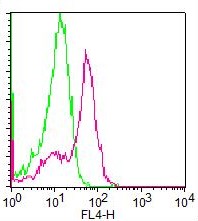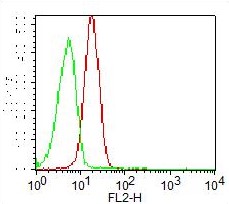Anti-CD184 / CXCR4 Monoclonal Antibody (Clone:12G5)-APC Conjugated
Shipping Info:
For estimated delivery dates, please contact us at [email protected]
| Amount : | 100 tests |
| Isotype : | Mouse IgG2a |
| Storage condition : | Store in the dark at 2-8°C. Do not freeze. Avoid prolonged exposure to light. |
CD184, also known as CXCR4 or fusin, is a receptor for the C-X-C chemokine SDF-1. It is expressed mainly in hematopoietic cells, vascular endothelium, and neural tissue. CD184 is a G-protein coupled receptor containing extracellular N-terminal, seven transmembrane domains and intracellular C-terminal domain. It transduces signal by increasing the intracellular calcium level. CD184 plays an essential role in vascularization of the gastrointestinal tract, and is involved in cerebellar development and in hematopoiesis. It is also a coreceptor (with CD4) for HIV-1 X4 virus and a primary receptor for some HIV-2 isolates.
| Subcellular location: | Cell membrane, Cell junction, Early endosome, Late endosome, Lysosome |
| Post transnational modification: | O- and N-glycosylated. Asn-11 is the principal site of N-glycosylation. There appears to be very little or no glycosylation on Asn-176. N-glycosylation masks coreceptor function in both X4 and R5 laboratory-adapted and primary HIV-1 strains through inhibiting interaction with their Env glycoproteins. The O-glycosylation chondroitin sulfate attachment does not affect interaction with CXCL12/SDF-1alpha nor its coreceptor activity. |
| Tissue Specificity: | Expressed in numerous tissues, such as peripheral blood leukocytes, spleen, thymus, spinal cord, heart, placenta, lung, liver, skeletal muscle, kidney, pancreas, cerebellum, cerebral cortex and medulla (in microglia as well as in astrocytes), brain microvascular, coronary artery and umbilical cord endothelial cells. Isoform 1 is predominant in all tissues tested. |
| BioGrid: | 113607. 43 interactions. |
|
There are currently no product reviews
|















.png)










